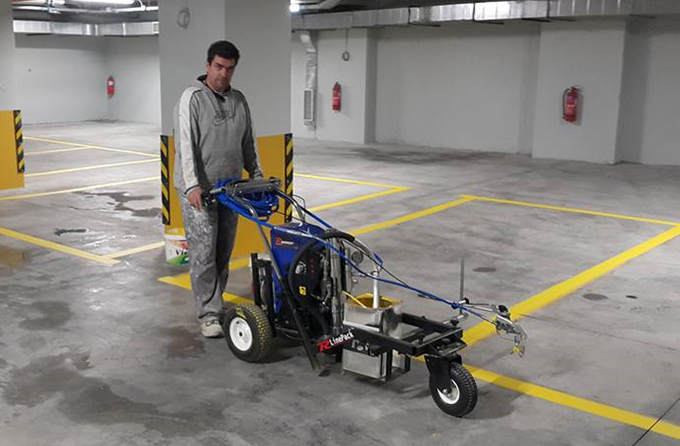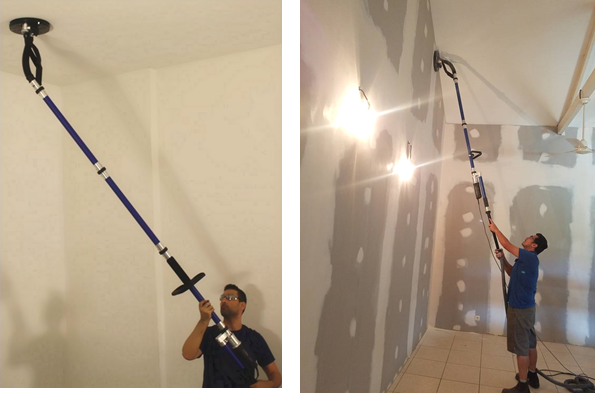How to choose an airless paint sprayer
First of all, we need to understand why to use an airless paint sprayer, what advantages does a paint sprayer offer contractors and what size of airless sprayer is suitable for each average contracting job.
Minimal material waste is probably one of the most important facts of using an airless paint sprayer. In most cases and especially on a heavy duty airless paint sprayer, you will find a double method of material suction, so for example when spraying paint you can use a suction hose and with thicker materials you would work with a direct immerse pump. With these material input methods and the atomization procedure, you have already gained material therefor money.
Airless paint sprayers offer faster coverage than a roller or a brush application. With a sprayer it is easier to apply paint to a large variety of surfaces (walls, ceilings, indoor – external coatings, floors etc.) By adding accessories to your sprayer, you can reach high and inaccessible surfaces, increasing your productivity and saving time & cost.
Airless sprayers have a paint pump that pushes the material into a paint hose and out from a spray gun, at the output of the airless spray gun you will find a guard and a spray tip. The spray tips come in a large variety of sizes depending of the application and the desired fan pattern.
All airless spray tips have a three digit size guide for example 529.
The first digit indicate the width of the spray distribution or commonly the fan size, so in the above example the digit 5 – therefore you will be spraying at an angle of 50°
a) The second and third digits of the tip size indicate the size of the spray orifice, for example 29 matches an orifice of 0.029 inch or 0.736mm
Tip flow rate:
- The flow rate of the tip depends on several factors, among them:
- The airless sprayers pressure psi/bar
b) The used spray material
Higher the working pressure = higher flow
Always check your airless sprayer’s technical specifications before choosing an airless tip spray.
So now we have seen some basic facts of airless paint sprayers, we need to ask ourselves what size of sprayer fits my average coating job needs.
A few important questions are:
- Power = HP ?
Professional airless paint sprayer may be found either with electric motors or gas powered engines. So know the job site power source or you can always choose a convertible power airless sprayer.
- Average project size?
Think about your average jobs that you take on or bid, you don’t want to land up with a small unit that will limit your coating operation. If you most commonly work with commercial coatings and larger surfaces then a larger heavy duty airless sprayer may be appropriate for you. On the other hand if in average your painting jobs are small or housing renovations then a less powerful sprayer is probably ideal for you.
- What materials to you apply?
A large variety of materials may be sprayed with airless sprayers; therefor you need to be sure that the working pressure of your sprayer is appropriate for the material. For example if you are spraying heavy texture then you definitely need a high-pressure airless sprayer, always consult your material supplier of the psi / bar needed to spray the material.
- Volume of coating - pricing
Once again, when purchasing a paint sprayer you must take into consideration the payback time of this investment, you don’t want to land up spending more than you can afford.
- Number of spray guns?
How many users / how many simultaneously spraying? Heavy duty airless sprayers give you the opportunity to have multiple users spraying in order to get larger jobs done faster. Keep in mind that some spraying equipment can handle only one spray gun. This always depends on the contractor’s requirement per average jobs and time schedule.
How to convert paint sprayer to line striper
As a painting contractor, you often get a multi task painting job request from your clients. For example, you are preparing a bid for a commercial building that includes applying texture and paint coatings. Your client has also pointed out that there is a parking lot area that he wishes you to line stripe too.
A common solution would be for you to purchase a heavy duty gas powered airless sprayer for the commercial buildings coating needs and then either purchase an additional airless line striper or go the classic and old fashion way and start marking and painting with a roll….
No need to worry, VEZOS offers a new and innovative solution for difficult painting tasks.
An airless paint sprayer that can easily convert into a line striping machine, yes this is possible!
See how:
R-LinePack Transformable Line Striping Kit

VEZOS INNOVATION: 1st line striping kit


Transform your hydraulic airless sprayer into a line striper with a simple kit. Save the cost of an extra unit!

RUNNER Texture sprayer, is the ideal airless unit for contractors
that take on medium to large applications,offering its users an
outstanding 260 bar working pressure, convertible in power and
material input methods but not only! Yes, contractors can also
adapt the R-LinePack line striping kit without any extra tools and
transform the texture sprayer into a line striper.
 |
 |
 |
Transform: Convert power from electric to gas 

Transform: Convert material input method & add hose /gun

Transform: Connect the R-LinePack / no tools needed

Transform: Texture / paint Sprayer into a line striper

How to sand a ceiling easy - drywall sander
VEZOS INNOVATION: Extreme working height


Transform your drywall sander with VEZOS main extensions and gain an outstanding 7 meters working height!
How it works?
How to sand a ceiling easy - drywall sander
VEZOS Handysand drywall sanders, have been innovating in the sanding industry since 2004, offering contractors new technology and solutions, making the job easier and faster.
VEZOS suction effect enables the sander to grip to the surface allowing its user to simply drive the tool, instead of lifting the weight of the equipment. With its A.R.S. technology,
automatically regulating the suction force, the sander adjusts to each surface (wall / ceiling) providing the necessary suction each time.
So as we have the weight and lifting factor out of the way, the next step is to sand as high as possible without needing to use any scaffolding or ladders. This is possible
with VEZOS main and retractable extensions. No tools required to connect the drywall sanders extensions, simply screw the connecting nut on each extension by hand and adjust
the tools height. Transform the sander from a short neck version 97cm to a 7 meters working height avoiding time consuming scaffolding.
Transform: Short neck drywall sander


Transform: Long neck drywall sander

Transform: Long neck drywall sander 4 meters working height

Transform: Drywall sander amazing working height !

Tip size identification:
All airless spray tips have a three digit size guide for example 529.
The first digit indicate the width of the spray distribution or commonly the fan size, so in the above example the digit 5 – therefore you will be spraying at an angle of 50°
The second and third digits of the tip size indicate the size of the spray orifice, for example 29 matches an orifice of 0.029 inch or 0.736mm
Tip flow rate:
The flow rate of the tip depends on several factors, among them:
a) The airless sprayers pressure psi/bar
b) The used spray material
Higher the working pressure = higher flow
Always check your airless sprayer’s technical specifications before choosing an airless tip spray.
In the chart guide bellow you can see the suggested spray tips per unit & material:

Working pressure 138 bar - 13.8 MPa - 2000 psi with water
Delivery performance may vary depending on material thickness, hose length and diameter
